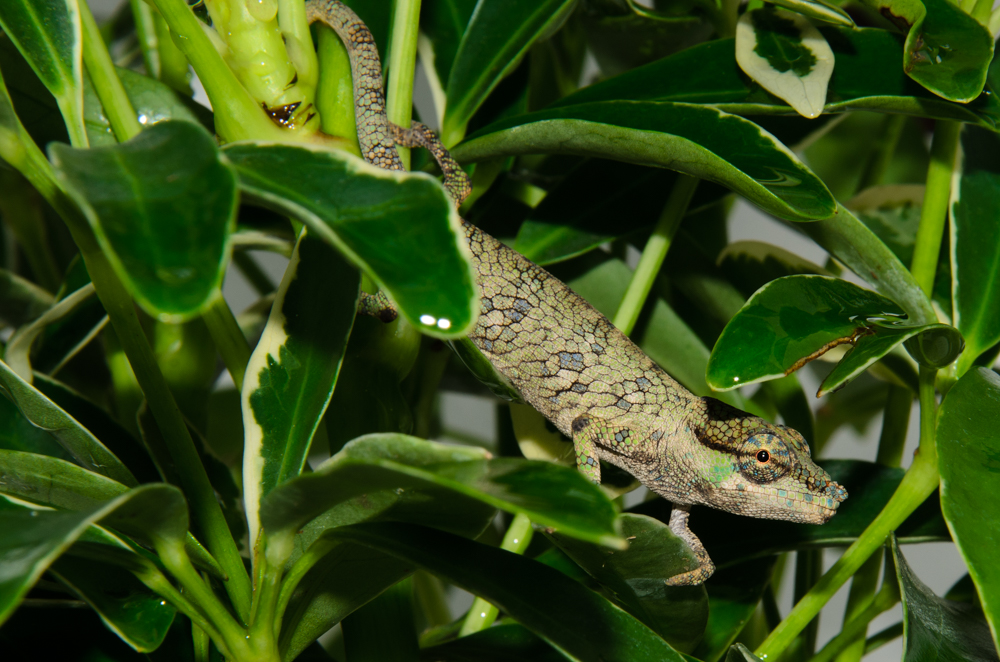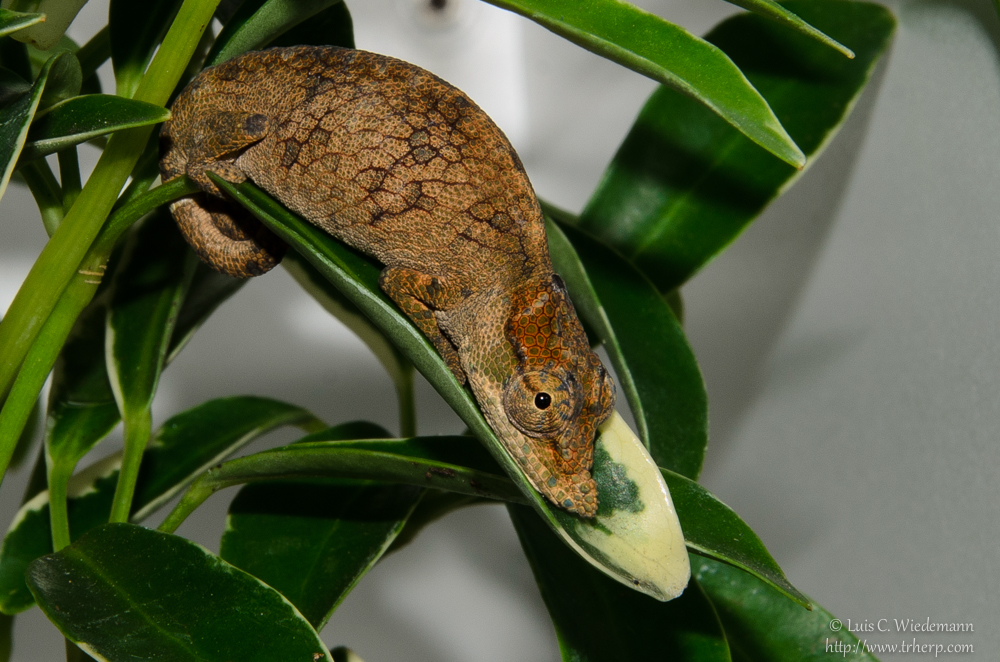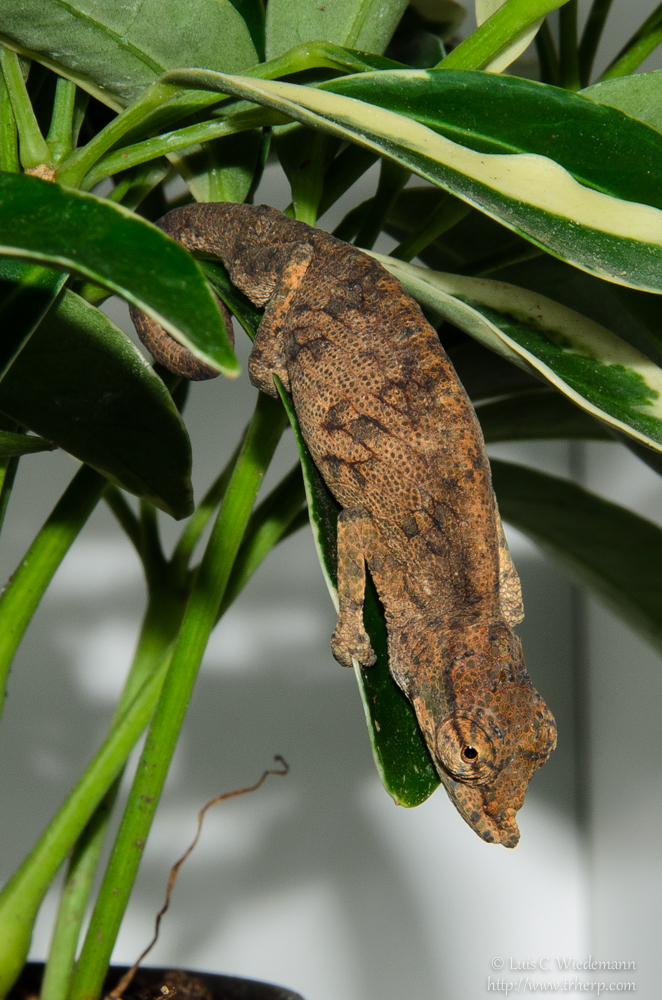Navigation
Install the app
How to install the app on iOS
Follow along with the video below to see how to install our site as a web app on your home screen.
Note: This feature may not be available in some browsers.
More options
You are using an out of date browser. It may not display this or other websites correctly.
You should upgrade or use an alternative browser.
You should upgrade or use an alternative browser.
Calumma nasutum
- Thread starter luevelvet
- Start date
luevelvet
Avid Member
Thanks!
Right now the temps are a little lower than usual, hovering around 70-72 during the day. I did provide one of the three cages we have them in (Dragon Strand Compact Cage System) with a warm spot and it appears that only the seemingly gravid females were interested in basking. I'm keeping misting at a minimum to try and prevent them from getting wet whilst the temps are this low opting instead for a dripper. They seem only interested in water in the morning hours and go hunting in the afternoon. Very interesting species for sure!
Right now the temps are a little lower than usual, hovering around 70-72 during the day. I did provide one of the three cages we have them in (Dragon Strand Compact Cage System) with a warm spot and it appears that only the seemingly gravid females were interested in basking. I'm keeping misting at a minimum to try and prevent them from getting wet whilst the temps are this low opting instead for a dripper. They seem only interested in water in the morning hours and go hunting in the afternoon. Very interesting species for sure!
Motherlode Chameleon
Chameleon Enthusiast
Luis
Great pick ups Luis! Good luck with your breeding program.
Best Regards
Jeremy A. Rich
Great pick ups Luis! Good luck with your breeding program.
Best Regards
Jeremy A. Rich
Last edited:
Motherlode Chameleon
Chameleon Enthusiast
Even though there are many conservation problems through out much of the tropical African region Calumma nasutum is listed as species of Least Concern by the IUCN Red List. That is the least threatened level ranking given by the IUCN Red List. That stated and even though they are a Calumma species (that are renowned for there difficulty to breed) I recommend looking to buy captive bred Calumma nasutum over wild caught if you have got the opportunity. That takes pressures off of wild populations.
http://www.iucnredlist.org/details/172861/0
Best Regards
Jeremy A. Rich
http://www.iucnredlist.org/details/172861/0
Best Regards
Jeremy A. Rich
Last edited:
luevelvet
Avid Member
Thanks again everyone!
Jeremy,
As much as I'd love to acquire CB's C.nasutum, these are some of the first to arrive to the US in many years so hopefully and with a little bit of luck, we can see some eggs from these initial imports and start the captive population going. From what I've heard from folks who live and have been to Madagascar, C.nasutum is everywhere and judging by their range, it doesn't surprise me they are of Least Concern at the moment. That doesn't change my intentions to treat them like gold as I don't know when we'll see them again or if they'll be in this good of condition next time.
Working with WC's is never a good idea for the casual hobbyist IMO. The unfortunate truth is some will perish during the whole process but with the state of governance in Madagascar, captive populations of Malagasy species is one way to attempt to ensure their survival. We just need to make sure these initial imports wind up in good hands so they have the best chance possible to fulfill their new destiny's.
This is of course our approach and one that may not be shared by everyone. However, without the opportunity to work with these species we will never have a chance to get them established in captivity. Again, they're not for everyone and should only go to folks who know what they're trying to accomplish and have the means to do so.
Luis
Jeremy,
As much as I'd love to acquire CB's C.nasutum, these are some of the first to arrive to the US in many years so hopefully and with a little bit of luck, we can see some eggs from these initial imports and start the captive population going. From what I've heard from folks who live and have been to Madagascar, C.nasutum is everywhere and judging by their range, it doesn't surprise me they are of Least Concern at the moment. That doesn't change my intentions to treat them like gold as I don't know when we'll see them again or if they'll be in this good of condition next time.
Working with WC's is never a good idea for the casual hobbyist IMO. The unfortunate truth is some will perish during the whole process but with the state of governance in Madagascar, captive populations of Malagasy species is one way to attempt to ensure their survival. We just need to make sure these initial imports wind up in good hands so they have the best chance possible to fulfill their new destiny's.
This is of course our approach and one that may not be shared by everyone. However, without the opportunity to work with these species we will never have a chance to get them established in captivity. Again, they're not for everyone and should only go to folks who know what they're trying to accomplish and have the means to do so.
Luis
Last edited:
luevelvet
Avid Member
From the limited information that I was able to dig up, it did suggest the incubation was around 90 days, which is very much in line with the Uroplatus and T.deremensis we already focus on. It appears that we have at least 2 females that may be gravid and they're both doing seemingly well.
They are unlike any diminutive species I've worked with to date. They have the behavior of the larger species but in a 2" body. Not to take away anything from the larger Calumma species that also came in but I can't see any of those really being in the same ball park as these nasutum IMO.
Cheers!
Luis
They are unlike any diminutive species I've worked with to date. They have the behavior of the larger species but in a 2" body. Not to take away anything from the larger Calumma species that also came in but I can't see any of those really being in the same ball park as these nasutum IMO.
Cheers!
Luis
Chase
Chameleon Enthusiast
Luis,
I'm kind of most excited about C. nasutum so far in regards to what has come in. They are very cool and have a shorter incubation period, correct? It's probably all we are likely to see offspring from with this initial import anyway-so I hope you get some!
It is about a 4 month incubation from what I have read. They're also more active than the bigger Calumma (just what I've seen, and they move around a lot, and I've read the bigger Calumma are more sedimentary).
I'm also very excited about these
Chase
Motherlode Chameleon
Chameleon Enthusiast
Thanks again everyone!
Jeremy,
As much as I'd love to acquire CB's C.nasutum, these are some of the first to arrive to the US in many years so hopefully and with a little bit of luck, we can see some eggs from these initial imports and start the captive population going. From what I've heard from folks who live and have been to Madagascar, C.nasutum is everywhere and judging by their range, it doesn't surprise me they are of Least Concern at the moment. That doesn't change my intentions to treat them like gold as I don't know when we'll see them again or if they'll be in this good of condition next time.
Working with WC's is never a good idea for the casual hobbyist IMO. The unfortunate truth is some will perish during the whole process but with the state of governance in Madagascar, captive populations of Malagasy species is one way to attempt to ensure their survival. We just need to make sure these initial imports wind up in good hands so they have the best chance possible to fulfill their new destiny's.
This is of course our approach and one that may not be shared by everyone. However, without the opportunity to work with these species we will never have a chance to get them established in captivity. Again, they're not for everyone and should only go to folks who know what they're trying to accomplish and have the means to do so.
Luis
Luis
You did not understand and what I meant and I should have elaborated more. I am acquainted with the fact that there are no captive bred Calumma nasutum available yet in the United States and North America. I was just stating that as this species becomes available people should/highly recommend look to buy from breeders first then wild caught second. That possibly means with some time and luck you Luis!
Best Regards
Jeremy A. Rich
Last edited:
luevelvet
Avid Member
I didn't mean to sounds curt either, I was just expressing our take on it. But I agree with your statement whole heartedly. Anyone truly interested in these species should wait until we (the royal we, not just me of course!) figure them out first. The cost of the animal is just the beginning but enclosures, vet bills, meds etc all add up and can make or break the project in an instant almost.
Luis
Luis
rsepiphyte
Established Member
Beautiful chameleons. Thank you for sharing them with us and best of luck with them. Ruth
Similar threads
- Replies
- 11
- Views
- 600
- Replies
- 4
- Views
- 805
- Replies
- 0
- Views
- 553









